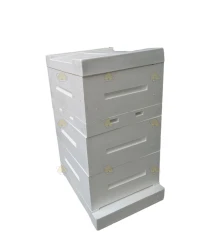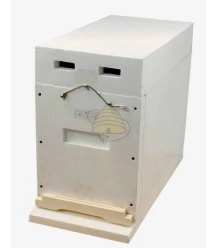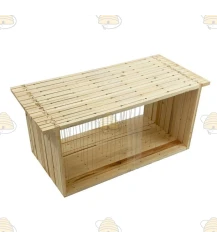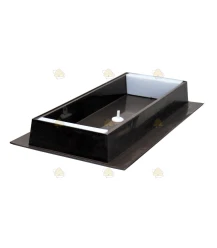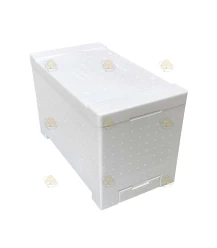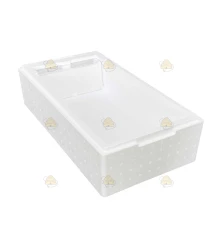Zander polystyrene hives
The Zander beehive is also available in a plastic version. This is the Zander polystyrene beehive. This hive is also known as the Zanderbeute. This beehive is also available in wood; you can find it in the category wooden beehives. The hive consists of 2 or 3 removable sections: the upper section is the honey super and the lower section is the brood box (brood chamber). Both the brood boxes (brood chambers) and the honey supers are the same size. This is one of the innovations in the Zander beehive.
The advantage of the plastic Zander beehive
A plastic beehive handles moisture well and insulates effectively, which means the colony loses little heat. The plastic beehive must also be painted to protect against UV light, because plastic can degrade. For this you use special paint for plastic beehives. The plastic Zander beehive can also be supplied painted. It then comes ready to use. After the hive has been painted, you can house a colony in it. A plastic beehive requires little maintenance, just painting and occasional touch-ups. This is the only maintenance. You are therefore assured of a beehive that will last a long time. The hive is also super lightweight, making it easy to move.
Disadvantages of a plastic beehive
A plastic beehive also has drawbacks. Small dents can occur more easily when using the hive tool because the material is softer than wood. However, this also depends on how carefully the beekeeper handles the tool. These polystyrene Zander beehives are made from a high-density polystyrene, which keeps damage during use to a minimum. Want to read more about the history of the Zander beehive? Then take a look at the category wooden Zander beehives.
-
Zander beehive (polystyrene)
€ 262,45 In stock and available for immediate delivery.Polystyrene Zander beehive, made of expanded polystyrene ('foam'). The material is identical to that of Segeberger hives but is sturdier. This is due to the higher-density pressing. Thanks to this design, the beehive is extremely robust yet lightweight. The hive consists of: a roof a brood box two honey supers intermediate board with 7 ventilation holes...View more -
Zander beehive green (polystyrene)
€ 262,45 In stock and available for immediate delivery.Polystyrene Zander beehive, made of expanded polystyrene ('styrofoam'). This beehive comes ready-painted in green. The material is identical to the material of the Segeberger hives but stronger. This is due to the heavier pressing. This heavy-duty design makes the beehive extremely sturdy yet lightweight. The hive consists of: a roof three brood...View more -
Zander 6-frame polystyrene nuc box
€ 69,25 This product is ordered, delivery time is approximately 21 days.6-frame Zander nuc box made of polystyrene. Polystyrene is similar to the material used for Segeberger ('foam') hives but is stronger, making these Zander hives exceptionally robust yet lightweight. The box consists of a roof and a brood box with an integrated floor and landing board. An entrance slider is included. Internal dimensions: width 22.6 cm,...View more -
Zander brood frames assembled 220 mm pine (per 10 pcs.)
€ 16,45 In stock and available for immediate delivery.Zander brood frames assembled in pine for the Zander hive, sold in packs of 10. These frames are made from high-quality pine. The frames are fitted with four horizontal 0.4 mm stainless-steel wires and brass eyelets, so no corrosion occurs during formic acid (methanoic acid) treatments. Furthermore, the frames are knot-free and precisely assembled and...View more -
Zander brood frames Hoffmann 220 mm assembled pine (per 10 pcs.)
€ 15,95 In stock and available for immediate delivery.Zander brood frames with Hoffman side bars, assembled in pine wood for the Zander hive, packed per 10 pcs. These frames are made of high-quality pine. The frames are fitted with four horizontal 0.4 mm stainless-steel wires and brass eyelets so no corrosion occurs during formic acid treatments. Furthermore, the frames have no knots in the wood and are...View more -
Feeder for 6-frame polystyrene nuc box
€ 14,95 In stock and available for immediate delivery.Feeder for 6-frame polystyrene nuc boxes. This feeder fits under the roof of the following 6-frame polystyrene/EPS nuc boxes: Dadant Blatt / Frankenbeute, Langstroth and Zander. On two sides of the feeder there are openings that let the bees easily access the feed.View more -
Six-frame Zander EPS polystyrene swarm box
€ 45,85 In stock and available for immediate delivery.Six-frame Zander. A nucleus hive (nuc box) made of EPS for housing a small colony or accommodating a swarm. Ideal to have ready or to take along in the car. Made of EPS (expanded polystyrene). Once painted, it looks great. Thanks to the insulating properties, colonies can also overwinter well in these boxes. This box is made for Zander hive frames.View more -
Feeder EPS six-frame nuc box simplex / DNM / Zander
€ 22,95 In stock and available for immediate delivery.Top feeder for an EPS six-frame nuc box in Simplex / German Normal / Zander sizes. Thanks to the excellent insulating properties of EPS (plastic) nuc boxes, colonies can be overwintered in them. The feeder comes with an internal divider.View more


